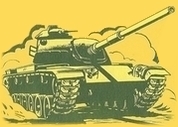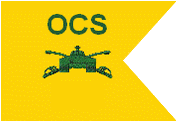Background:
For the first 140 years of our Nation's
history West Point was able to provide the professional officer
corps for our small regular standing army. During military
build ups for the War of 1812, the Mexican American War, the Civil
War, and the Spanish American War the State Militias and Volunteer
Units often elected officers from leaders in their local community.
The few military colleges/academies provided an additional resource
for officers. The large scale mobilization for World War I created
a need for a large number of officers. In 1916 Congress
enacted the National Defense Act of 1916 which created the Reserve
Officer's Training Corps to create a pool of reserve officers who
would serve during times of need. These officers would not be
available until 1920. The Secretary of War then proposed changing
several civilian training camps into officer training camps.
The camps became known as Officer Candidate Schools and were held
at various military installations. Officer candidates received
three months of intensive training in leadership and other subjects
needed to prepare them to lead men in combat. By June of 1918, almost 60,000 graduates
had been commissioned in the Army. At the time of the Armistice
there were almost 50,000 candidates enrolled in the last of the
schools.
Graduates of these World War One training
programs were soon dubbed “90 Day
Wonders” because of the three month length of the class. It
was the experience gained in World War One that led to the program
and methods used in OCS ever since. The concept for Army officer training at
officer candidate schools is now over one hundred years old.
Because of the successful record those early officer candidate
schools achieved during World War One, when they quickly produced
officers when needed, they were again activated during World War
Two, the Korean War, and the war in Vietnam.
The First
Time: World War Two - 1941-1945
The
War Department envisioned an Army of some 4,000,000 men. By the end
of the war almost 8.5 million men would serve in the Army. 19,000
officers had come from the National Guard, and 18,000 from the
Officers’ Reserve Corps, but 280,000 were produced by the Army
through the training of enlisted men who became officers. To
get these officers, General George C. Marshall ordered the
formation of Officer Candidate Schools in the various branches
including Armor.
As
tank warfare’s importance grew, the Army turned to Fort Knox to
produce Armor officers sufficient to lead the tank battalions that
would be part of 16 armored divisions, plus 65 independent tank
battalions. The mastermind of the new armored force was a former
cavalry officer, MG Adna R. Chaffee, Jr. Chaffee,
(biography of MG Chaffee) whose
headquarters was at Fort Knox. In July, 1940, the first men began to
arrive at Fort Knox. On July 25, 1940, Lieutenant Colonel
(later Major General) Stephen Henry was directed to plan, organize
and operate an armored forces school. The Secretary of War approved
the school on September 19 and the school became the place for
doctrine development and armor education. The first classes of
Officer Candidate School at Fort Knox graduated in August 1941. The
school continued to produce new officers until it was closed after
the last classes which entered in November, 1944, graduated. The
graduates had undergone the basic phase, plus additional training
totaling 17 weeks to emerge as second lieutenants. Officially, OCS
at Fort Knox produced 11,349 officers. While most of these served
in armored units, many led anti-tank units and other units
necessary to support the mobile force the United States produced,
probably the most mobile force of the war.
The Second Time:
The Korean War - 1951-1953
The
United States entered the Korean War as the greatest military power
in the world. The Army, which had been reduced from 8.5 million
personnel in August, 1945, still had a strength of some 600,000
troops. However, this force was located in several places around
the world, particularly in Europe. The 111,430 in Japan, the
Philippines, and Okinawa were not enough to fight the battles in
Korea. In June, 1950,
the United States had a reserve corps of 217,435 officers and
291,182 enlisted men. The Pentagon quickly realized that the
numbers of World War Two veterans and young officers produced by
West Point and college ROTC programs would be insufficient to lead
the platoons and companies formed as the Army expanded. Planners
thus reinstated Officer Candidate School, in February, 1951. The
reactivated program was 22 weeks long, up from the 17 weeks of
World War Two. By the end of 1952, the Army had commissioned more
than 15,000 officers through OCS. The need for an increasing
number of mobile troops for use both in Korea and on the plains of
Europe caused the Army to open OCS at Fort Knox a second time on
September 28, 1951. As Captain Thomas J. Canavan observed in
his essay “Let’s Keep Armor OCS” (paper, United States Army Armor School,
1967):
The program was to consist of 11 classes
with 100 candidates per class. This time, however, they were to
receive 22 weeks of training - a five week increase over World War
II O.C.S. (sic) In addition, a class was to graduate every other
week. At first, these goals were not reached. The first three
classes had more than 100 candidates and started about one month
apart. It was not until the fourth class that the Officer Candidate
School was able to proceed as planned. The program was retained at
Fort Knox until 12 May 1953, during which time 1,256 lieutenants
received commissions. Thus, on May 12, 1953, the Army closed
OCS at Fort Knox a second time. One side note of interest is that
while officer candidates were housed in the large red brick
barracks (now offices) on main post during World War Two and
Vietnam, Captain Canavan says the candidates in 1951-1953 were
housed in wooden barracks north of the Armor School, possibly near
where Boudinot Hall now stands.
The Third
Time: The Vietnam War - 1960-1972
During Vietnam the United States Army was called upon to quickly
train some 375,000 troops and then to deploy them to Southeast
Asia, the continental United States, Europe, Korea, and elsewhere
around the world. To lead this force, about 40,000 new officers
were needed, a 40 percent increase in the pre-war officer
corps. The expansion
of the officer corps had to take place between 1965 and 1969 and
had to be accomplished in a shorter time period than that which had
occurred during the much larger World War Two expansion. The main
source of these new officers was Officer Candidate School.
About ten percent of these needed officers were trained at the
Armor School at Fort Knox, Kentucky, between December, 1965, and
March, 1968.
On
August 26, 1965, the Department of the Army ordered the Armor
School at Fort Knox to activate an Officer Candidate School. The
OCS there was one of the first to get underway. The Officer
Candidate School itself was under the direction of the Assistant
Commandant of the Armor School, Brigadier General Albin Irzyk. BG
Irzyk was a famed armor battalion commander who during World War
Two served under General George S. Patton, and alongside future
General Creighton Abrams. BG Irzyk was Assistant Commandant
throughout most of the life of the Officer Candidate School at Fort
Knox and he took special interest in it and its product. Though
most candidates did not know it at the time, his spirit and
dedication would be stamped on each of them. Following his
assignment at the Armor School, General Irzyk returned to Vietnam
for his second tour where he played a key role in saving Saigon
during the TET Offensive in the spring of 1968.
Because the Armor School was among the first to establish an OCS,
the Army stipulated that during its first fiscal year of operation
from 1 October, 1965, through 30 June, 1966, the school was to
train some students only for the thirteen week branch immaterial
curriculum common to all Officer Candidate Schools while retaining
others for an additional ten weeks of training as Armor officers.
Those sent elsewhere finished their training in Transportation,
Ordnance, or Quartermaster branch schools. After July 1, 1966, the
Officer Candidate School at Fort Knox prepared only Armor officers
through a full 23 week long course. The last OCS class at Fort Knox graduated
on February 23, 1968. For the period December, 1965, through
February, 1968, Fort Knox OCS trained and commissioned 3,354 second
lieutenants in Armor, 21 in the Transportation Corps, ten in the
Ordnance Branch and seven in the Quartermaster Corps. In addition,
929 individuals completed thirteen weeks of Fort Knox OCS Phase I
training before being sent to Ordnance, Quartermaster, or
Transportation branch school. 4,321 men completed Officer
Candidate School in the Officer Candidate Brigade of the United
States Army Armor School at Fort Knox, Kentucky and then served
their Nation during the Vietnam Era. 115 graduates as a result of
service in Vietnam were killed in action, died of wounds, or died
from service related injuries.
Note: A more
detailed history of OCS at Ft. Knox is in our book,
When the Nation Called a
Third Time: Army Officer Candidate School at Fort Knox,
Kentucky: The Vietnam Era. The book is available for purchase by going
to the "OCS Book
Information" page.
|

 Home
Home About
Us
About
Us Announcements
Announcements Brigade
Cadre
Brigade
Cadre Class
Narratives
Class
Narratives Class
Rosters
Class
Rosters Class
Statistics
Class
Statistics Class Web Pages
Class Web Pages Distinguished
Distinguished Documents
Documents Fiddler's Green
Fiddler's Green General
Officers
General
Officers Hall of
Fame
Hall of
Fame Heraldry
Heraldry History
History Medal of
Honor
Medal of
Honor Media
Media OCS
Book
OCS
Book Photos
Photos Reunions
Reunions Roll
of Honor (KIA)
Roll
of Honor (KIA) Virtual Cemeteries
Virtual Cemeteries What's
New
What's
New
 Armor
Links
Armor
Links OCS
Links
OCS
Links Veteran Links
Veteran Links Doug
Burmester
Doug
Burmester John
Moore
John
Moore Hugh
Preacher
Hugh
Preacher
